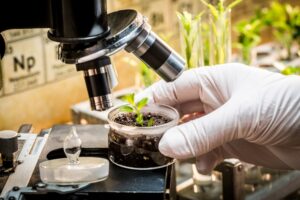Scientists generally accept 17 key elements essential for plant growth (authors- Barker and Pilbeam, 2007). These elements are:
- Carbon (C),
- Hydrogen (H),
- Oxygen (O),
- Phosphorous (P),
- Potassium (K),
- Nitrogen (N),
- Sulfur (S),
- Calcium (Ca),
- Magnesium (Mg),
- Iron (Fe),
- Boron (B),
- Manganese (Mn),
- Copper (Cu),
- Zinc (Zn),
- Molybdenum (Mo),
- Nickel (Ni), and
- Chlorine (Cl)
A specific amount of each of these nutrients—the Crop Nutrient Requirement or CNR — is vital for crops to complete their life cycles and to produce a desired yield.While carbon and oxygen are obtained from air, and hydrogen from water.
The remaining nutrients can be gathered from the soil; however, the soil may not always contain adequate amount of these nutrients for optimal crop production, and this can be found using a soil nutrient tester in the USA. Farmers need to know that only a part of the CNR that can be accumulated from the soil layer because these nutrients are essentially free to the farmer. Suppose the CNR cannot be provided entirely from the soil. In that case, the soil-supplied nutrients can be boosted with fertilizers or other nutrient sources such as manures or composts.
Steps in Soil Nutrient Analysis:
Soil analysis can provide important information about physical conditions, fertility (nutrient) status, and chemical properties affecting soil’s ability to grow plants. The steps associated with soil nutrient testing include:
1) Soil sample collection,
2) Laboratory analysis,
3) Interpretation of results
4) Fertilizer management recommendations.

Source- Freepik
1) Soil Data Collection:
The first and foremost step in soil analysis is soil data collection. The most standard method is soil sampling. However, it’s important to realize that only a tiny portion of a field is analyzed in the laboratory. Thus, collecting a representative soil sample is critical for accurate results. The most common method is composite sampling. Sub-samples are collected from randomly selected locations in the field. The sub-samples are thoroughly mixed to obtain a representative sample, and analysis of this sample gives average values for the entire area. Although the number of sub-samples depends on field size and uniformity, at least five sub-samples should be taken, and 15 to 25 are preferred. Usually, samples are collected at about 6 to 8 inches or an adequate rooting depth.
2) Laboratory Analysis:
A soil test determines the soil nutrient’s supplying capacity by mixing soil during the analysis with a powerful extracting solution (often an acid or a combination of acids). The soil reacts with the extracting solution, releasing some of the nutrients. As soil supplies most of the mineral nutrition for higher plants through the plant’s system, the extracted nutrient concentration is evaluated based on research that relates plant utilization to soil nutrient concentrations. This works well for some nutrients but needs to be more accurate for others. Nutrients supplied from soil organic matter (OM) decomposition (such as nitrogen and sulfur) depend more on the rate of OM decomposition than on extractable levels of these nutrients. Standard or routine soil tests vary from laboratory to laboratory but generally include the following:
- Soil texture.
- Electrical conductivity (EC, a measure of soil salinity).
- Soil pH.
- Available phosphorus (P), potassium (K), calcium (Ca), and magnesium (Mg).
- Sodium (Na).
- Cation exchange capacity (CEC).
- Often, an analysis of OM content.
Most laboratories offer nitrogen (N), sulfur (S), and micronutrient analyses for an additional cost. The methods used to test soils vary depending on their chemical properties, which are affected by geographic region.
Taking the process one step further than relying on lab samples alone, farmers can utilize other technologies such as proximal soil sensors, including gamma radiation spectrometry, to add additional layers within the data set to provide a more comprehensive look at the soil profile.
3) Interpretation of Results:
Upon their soil data analysis, the laboratory will issue a Soil Analysis Report showing the results of each test and the units of measurement in each case. The presentation and format will vary, but it should also list the methods used to derive each result shown because independent interpretation is only possible knowing how the individual tests were done. Even so, if the methods differ from those routinely used in the region and have not been calibrated against fertilizer response trials in that region, independent interpretation is impossible anyway.
Especially when adding in added-value layers derived from sensing technologies, it’s recommended to consult with an agronomist or crop consultant to interpret the dense data sets and ensure that the correct plans.
4) Fertilizer Management Recommendations:
The laboratory or consultant usually supplies interpretations as part of soil analysis, including whether individual soil tests are low, medium, or high. The laboratory may also provide fertilizer recommendations based on the analysis, although these recommendations are plant—and soil-specific. Routine sampling and analysis can be valuable tools for managing small acreages. Maintaining a record of soil analysis results can also give useful information on long-term changes in soil properties.
In Conclusion:
Soil analysis is essential for determining the exact amount of the crop nutrient requirement that can be supplied from the soil. It is most effective for nutrients that are not very mobile in the soil. Soil testing is an essential management practice. Farmers practicing correlated and calibrated soil analysis will benefit from appropriate fertilizer-rate applications and will protect the environment from any kind of nutrient pollution due to inappropriate fertilization practices.
Contact our experts at SoilOptix® to learn the benefits of soil mapping to better understand your farm’s nutrient needs! Visit https://soiloptix.com/.
Reference:
Barker, A. V., and D. J. Pilbeam. 2007. Handbook of Plant Nutrition. CRC Press, Taylor and Francis Group. Boca Raton, FL.
